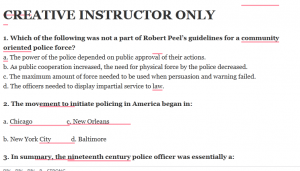CREATIVE INSTRUCTOR ONLY

1. Which of the following was not a part of Robert Peel’s guidelines for a community oriented police force?
a. The power of the police depended on public approval of their actions.
b. As public cooperation increased, the need for physical force by the police decreased.
c. The maximum amount of force needed to be used when persuasion and warning failed.
d. The officers needed to display impartial service to law.
2. The movement to initiate policing in America began in:
a. Chicago c. New Orleans
b. New York City d. Baltimore
3. In summary, the nineteenth century police officer was essentially a:
a. Crime fighter c. Federal agent
b. Political operative d. “Keystone Kop”
4. The problem of police-community relations was perhaps more _______ in the nineteenth century than in the late twentieth century.
a. Ambiguous and complex
b. Volatile yet simple
c. Insignificant yet commonplace
d. Rare yet dictatorial
5. During the decade of the early 1900s, the most important change in policing was the advent of the:
a. Automobile c. Baton
b. Telephone d. Two-way radio
6. Major developments in policing during the 1930s included all but which of the following?
a. A redefinition of the police role
b. The appearance of genuine empirical studies of policing
c. The rejection of the crime fighter image by police departments
d. The ascendancy of the crime fighter image
7. The Community Patrol Officer Program (CPOP) was instituted in 1984 in:
a. New York City c. Los Angeles
b. Denver d. Miami
8. This commission completed the first national study of crime and criminal justice, issuing 14 reports.
a. National Advisory Commission on Criminal Justice Standards and Goals
b. National Advisory Commission on Civil Disorders
c. Wickersham Commission
d. Kennedy Commission
9. Newark’s evaluation of foot patrol found all but which of the following outcomes?
a. Increased satisfaction with police service
b. Crime rates greatly decreased
c. A significant reduction of perceived crime problems
d. Increase in perceived level of safety of the neighborhood
10. First and foremost, to address terrorism COPPS can assist by encouraging:
a. Greater expenditures for biological terrorism research
b. More protection for members of the media to report an attack
c. Less bickering in Congress for terrorism preparedness
d. The police and citizens to work together to ensure our collective safety
11. Peel’s reform effort encountered strong opposition during its first three years.
a. True
b. False
12. Community policing can be traced back to Peel’s philosophy on which he built his public police in 1829.
a. True
b. False
13. By 1840, only a few American cities had police forces based on Peel’s model.
a. True
b. False
14. The 19th-century police officer enjoyed widespread acceptance by the public.
a. True
b. False
15. During the “professional model” of policing, police organizations became law enforcement agencies, with the sole goal of controlling crime.
a. True
b. False
16. O. W. Wilson became the principal architect of the police reform strategy.
a. True
b. False
17. The professional model of policing effectively kept crime rates low during the 1960s and 1970s.
a. True
b. False
18. Under “team policing,” officers were divided into teams and assigned permanently to small geographic areas.
a. True
b. False
19. Goldstein found that police officers can solve all crimes successfully and work with citizens to solve problems.
a. True
b. False
20. Community oriented policing provides officers with a narrow use of discretion.
a. True
b. False